Author(s): Huang WL
Introduction: Marijuana remains the most widely used illicit substance in the United States and Europe. Marijuana, according to Chinese herbal medicine is what is known as a “Cold” herb, draining the essential energy called Yang primarily from the Liver, rendering the Liver relatively unable to perform its functions of moving physical and mental energy and containing it for when it is needed.
Purpose: to demonstrate that chakras’ energies replenishment is an important tool to treat patients with marijuana addiction.
Methods: one case report of a 26-year-old male patient. His father told him to search for a treatment beliving that he was in severe depression. At the medical apointment, he told to the doctor that he usually used marijuana after the divorce of his parents. Chakras’ energies measurement were done throught radiesthesia procedure that demonstrate that all his chakras were completely depleted in energy, all rate in one out eight. The treatment consisted in Chinese dietary counseling, auricular acupuncture with apex ear bloodletting and replenishment of the chakras with highly diluted medications according to the theory Constitutional Homeopathy of Five Elements Based on Traditional Chinese Medicine.
Results: the patient improved very quickly from his depression symptoms and it was possible to suspend the use of marijuana in the first two weeks of treatment.
Conclusion: to treat patients with addiction in marijuana it is important to balance the internal energies and replenish the chakras’ energies deficiencies, improving self-steam, depression, anxiety, fear, sleep, sexual function, etc, giving the energy condition to live normally.
Marijuana remains the most widely used illicit substance in the United States and Europe [1].
According to the United Nations, in 2018, about 269 million people used drugs worldwide, 30% more than in 2009. At the same time, more than 35 million users suffered from disorders caused by drug use [2].
Cannabis, used in the production of marijuana, remains the most widely used substance worldwide, with 192 million users [3].
According to the National Institute of Science and Technology for Public Policies on Alcohol and Other Drugs, more than 60% of marijuana users first tried the drug before the age of 18 [4].
In Brazil, 7% of the adult population has tried marijuana in their lifetime, representing 8 million people. 3% of the adult population frequently uses marijuana, which is equivalent to more than 3 million people [4, 5].
As for use in adolescence, almost 600,000 teenagers (4% of the population) have used marijuana at least once in their lives, while the rate of use in the last year was more than 470,000 teenagers [4, 5].
It should be noted that more than half of the users, both adults and adolescents, use marijuana daily (1.5 million people) [4, 5].
This article was written based on Hippocrates thoughts that said that it is important to consider ancient medicines prior the knowledge we have today and for this reason, the author will use the fundamentals of traditional Chinese medicine to explain the energies alterations that chronic user of marihuana have [6].
The purpose of this study is to demonstrate that chakras’ energies replenishment is an important tool to treat patients with marijuana addiction. The treatment with Chinese dietary counselling, auricular acupuncture with apex ear bloodletting and replenishment of the chakras’ energies centers with homeopathy according to the theory Constitutional Homeopathy of the Five Elements based on Traditional Chinese Medicine and the use of crystal based medications are important tools to regulate this dysfunction and treat the root of the problem.
For the construction of this article, it was done an integrative literature search at PubMed related to marihuana use according to Western medicine and traditional Chinese medicine and also, it was used one case report to illustrated how the author did her reasoning and treatment.
The patient is a 26-year-old male with a history of first contact with marijuana at the age of 15, after having tried cigarettes and alcoholic beverages, but he did not like them and when he tried marijuana, according to his report, he had a great feeling.
In the beginning, he only smoked on weekends, always played sports and led a healthy life and marijuana until then did not interfere negatively in his life.
After a while, he started having problems at home due to the difficult relationship between the parents who constantly fought and put him and his brother in the middle of fights. This increased his use of marijuana, he still had a healthy and sexually active life with his girlfriend, but he was always feeling sad and out of place.
After losing his girlfriend with whom he had a 5-year relationship and being fired from the company he ran, he started using marijuana more and more, since it was the only thing that relaxed him.
He lost his taste for everything, food, friends, family, sports, he didn’t feel anything anymore, he just existed, without any perspective.
He started psychological treatments in several lines of study, underwent psychoanalysis treatment for a while, but as he found no solution to his sadness, he sought treatment with a psychiatrist who prescribed antidepressant drugs, which helped a little, but the side effects were very strong and he only used it for a year.
His father, seeing him in deep depression and failing to improve with any treatment, recommended him to come to the authors clinic.
The first step of the treatment was the Chinese dietary counselling
recommending to him to avoid all dairy products, raw foods,
cold drinks and sweets. Also, it was recommended to avoid fried
foods, chocolate, honey, eggs, coconut and alcoholic beverages.
The third group of foods to be avoided was coffee, soda and mate
tea. In addition, the patient received auricular acupuncture with
apex ear bloodletting once or twice a week.
The author also measured the energy of his five massive organs
through radiesthesia procedure, using a crystal pendulum. This
pendulum was placed in front of each person’s chakra. The result
of this measurement was that all his six chakras’ were in the
deepest level of energy, rated in one out of eight, with the exception
of the seventh chakra, that was normal.
The author recommended the use of homeopathies according to the theory developed by her entitled Constitutional Homeopathy of the Five Elements based on Traditional Chinese Medicine. The medications were orientated to intake in the following sequence described: Sulphur 30CHXX-20 (single dose), Calcarea carbonica 30CHXX-20 (single dose), Silicea 30CHXX-20 (single dose), Natrum muriaticum 30CHXX-20 (single dose), Phosphorus 30CHXX-20. The homeopathies were prescribed to be taken in a single dose with a hiatus of three days between the medications, necessarily on the sequence described. Two months later, a new sequence of treatment was started, with the same medications taken on the same order, but now with 200CHXX-20 instead of 30 CHXX-20. Two months later, a new sequence of treatment was started, as the others, with the same medications taken on the same order, now with 1000CHXX-20 instead of 200CHXX-20.
The patient improved very quickly from his depression symptoms and it was possible to suspend the use of marijuana in the first two weeks of treatment.
His father was very grateful because of the result of his treatment because no treatment he did until that day caused such improvement like the patient had with that treatment.
According to Classical Psychology, substance abuse can be explained by the human being’s tendency to repeat behaviors that produce pleasure and avoid displeasure [7].
Drugs act in areas of the brain associated with positive emotions
and which encourage encouraging behavior [7].
Currently, it is known that the reward mechanisms produced by
drugs in the brain relevantly involve at least six neurotransmitter
systems and six brain areas [7].
Chronic marijuana use causes chronic nausea and fatigue, lethargy,
headache, chronic throat, irritability, nasal congestion, worsening
asthma, frequent lung infections, decreased motor coordination,
impaired memory and attention, altered visual ability and abstract
thinking, menstrual problems, impotence, decreased libido and
sexual satisfaction, depression and anxiety, lability and irritability,
panic attacks, suicide attempts, social isolation, withdrawal from
leisure and other social activities [8].
In 1996, the World Health Organization acce pted acupuncture as
a treatment for drug abuse [9].
Prominent effects of acupuncture are increases in the levels of
encephalin, epinephrine, endorphin, serotonin, norepinephrine,
and dopamine in the central nervous system and plasma that might
mediate substance abuse. Acupuncture has been used to treat
addiction for three decades. For example, auricular acupuncture
(AA) is effective in treating alcohol and drug abuse in both Europe
and the United States. Before the author explains the concepts of
traditional Chinese medicine, she would like to show the reasoning
she used to treat the patients that started during the treatment of
one specific patient in 2006 [11].
This patient was a 70-year-old male patient, who reported pain
in the legs and was diagnosed with Kidney-Yang deficiency,
according to traditional Chinese medicine (TCM). He received
treatment with Chinese dietary counseling, acupuncture and
auricular acupuncture associated with apex ear bloodletting. [11]
With the treatment done, the pain in the legs diminished and the
patient was submitted to an interview 30 days after the treatment.
In this interview, the patient revealed that his eye pressure had
also lowered from 40 mmHg to 17 mmHg, as his ophthalmologist
confirmed. During the treatment, he had not reported to the author
to be treating glaucoma in the last 40 years with no improvement
of his condition [11].
This unusual case became the cornerstone her studies in the
field, trying to comprehend how the treatment focused on the
root of the problem could treat different diseases and symptoms
simultaneously and using the same methods [11].
The metaphor of tree has been used by the author to explain the
differences and integration between TCM and Western medicine,
as you can see in the Figure 1. The tree has a trunk with several
branches. Each branch represents one medical specialty and each
leaf coming out of each branch represents the symptoms and
diseases of each specialty. [12-15].
The leaves and the branches are the visible part and the object of study and practice in the Western medical profession because of the curriculum offered in the medical schools around the world. [12-15].
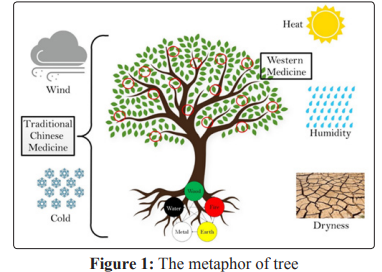
One of the theories that are in the root level is the theory of Yin and Yang. Yin and Yang are two opposite and complementary forces that exist in our world, in everything, including the human body. A possible example is day and night, men and women, good and bad [12-15].
For Yin and Yang energy to flow, two other energies have to work in harmony with it: Qi and Blood. Qi is the energy that circulates throughout your body. Qi moves the Blood that means if Qi stays stagnant long enough; the local body fluids that are supposed to be flowing begin to stagnate as well [12-15].
To achieve health, the main aim is to balance these four energies Yin, Yang, Qi and Blood, shown in the Figure 2.

The lack of energy of one of these energies or a combination of them can lead to the formation of internal Heat inside the body, as you can see in the Figure 3 [12-15].
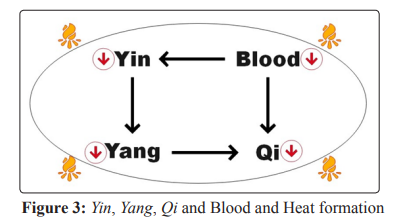
The other theory based upon traditional Chinese medicine principles of treatment is the Five Elements theory. The Chinese wise men were able to observe another feature from the nature, the relation between the five basic elements: Wood, Fire, Earth, Metal and Water. They observed a dynamic balance and relationship among these elements, in that they were so intertwined that if the balance was interrupted or destroyed, the elements would suffer, as you can see in the Figure 4 [12-16].
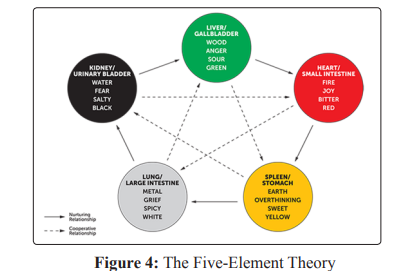
In the human body, each element is associated with a massive organ. The Wood element corresponds to the Liver and Gallbladder, and has the eye as its external sensorial organ, being responsible for vision. The emotion that unbalances the Liver is anger. The Fire element corresponds to the Heart and Small-intestine, represented by the tongue and subsequently language. The emotion that unbalances the Heart is excessive joy. The Earth element corresponds to the Spleen and Stomach, represented by the mouth and being responsible for taste. The emotion that unbalances the Spleen is excessive worry [12-16].
The Metal element corresponds to the Lungs and Large intestine, represents the nose, and is responsible for the sense of smell. The emotion that unbalances the Lungs is grief. Finally, the Water element corresponds to the Kidney and Bladder and represents the ears and hearing. The emotion that unbalances the Kidney is fear. In the table 1, you can see these correspondences with Five Elements theory and the five massive organs [12-16].
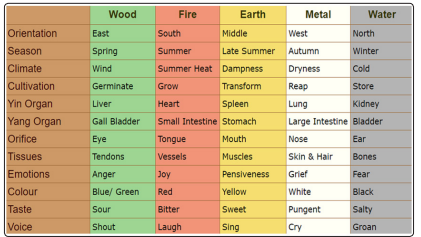
As there are seven chakras and five elements, the first and seventh correspond to Wood (Liver), the second and sixth correspond to Water (Kidney), the third to Fire (Heart), the fourth to Metal (Lung) and the fifth to Earth (Spleen), as you can see in the Figure 5 [12-16].
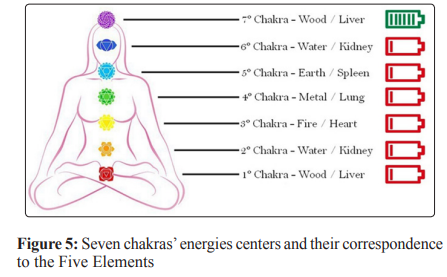
In Chinese medicine, there are the three treasures that constitute
our life. These are known as Jing (essence), Qi (vitality) and Shen
(spirit) Figure 6 [17].
To understand the meaning of each treasures that constitutes our
life, the author will explain them [17].
Jing is considered the essence that is the origin of life. It is stored
in the Kidney (second chakra) and it is essence it is called ShenJing [17].
According to Jarret, in the article entitled Shen-Jing as a Chinese
Medicine Concept Might Be a Counterpart of Stem Cells in
Regenerative Medicine, Shen would be a creative force , that
enable the organization of life . It would manifest in Jing and
Qi. The first will manifest in the raw material and in the second,
the movement, the agent transmission and transformation [17].
In relation to Shen, for Eyssalet, in the article entitled Shen: structuring category in the rationale of Chinese medical, Shen would be present in the conception of the individual and can be found in the reproductive cells, in the embryonic development, in the childs growth, in all the moments of evolution until the death [18].
Shen, in the point of view of Chinese medicine, determines the process of imbalance and healing [18].
The force that makes up and binding together the forces in the
Universe is called Qi. There are four types of Qi, according to
TCM: [19]
1. Parental Qi: is the force that in is inherited from our parents at
the moment of the conception and it is stored in the Kidney,
after the conception [19].
2. Pectoral Qi is the Qi that is produced by the breathing process
and it is stored in the chest area [19].
3. Nutritional Qi, is the Qi that came from the ingestion of foods
and it is responsible for the circulation of nutrition to all cells
and organs thought put the body [19].
Using marijuana, the patient will lose Jing and rapidly will lose Qi and Shen, thus the patient will lose a lot of essence over time, and since the patient’s body will, release Jing faster than the body can assimilate it. Over spending their allotted Jing makes us to understand why people who consume many drugs might look like they are aging faster than in normal people that do not use drugs [17-19].

The impact on the patients Yang is that, in the short term, there is an expansion of creativity and the visionary process. In the long run, there is a weakened visionary process and an inability to act. When the Liver, an emotional organ, is disturbed, red eyes, irritability and depression set in. Women experience an interruption of menstruation with worsening premenstrual symptoms (PMS) symptoms [20].
In Chinese, the word Heart is also used to denote mind. The Shen resides in the Heart and, while the person sleeps, Blood enters the Heart and calms the Shen. When they wake up, they feel refreshed. When marijuana enters in Heart, it may seem harmless at first. While awake, sudden flashes of anger arise and paranoia sets in. Without a strong Shen, the person seems lost and sleep is agitated and disturbed by nightmares and heart palpitations [20]. When Fire scorches the earth, the Yin of Earth is depleted, and the body has similar symptoms of hypoglycemia; blood sugar drops and the appetite is constantly hungry. If one is not in touch with what nourishes them, then they will eat random things, and might gain weight. Women will be prone to yeast and bladder infections because of the dampness from accumulated sugars eaten [20].
Marijuana affects the Lungs, skin and immunity. Specific symptoms are: the Lungs and skin become dry and red, and intense pimples appear on the Large intestine meridians on the face (around the mouth) and on the chest / upper back area around the lungs. There is usually a chronic cough with mucus. In the long run, there may be asthma or eczema or random Staphylococcus aureus infections. Regular marijuana smokers have breathing problems, such as deficiency of Lung Qi with Heat (sometimes producing small yellow nuggets of phlegm in the morning) [20].
When accessing water from the Kidneys, the Jing runs out. Thereis Fire from the Heart meridian and the vision of the patient could be affected by the Liver energies imbalances. Long-term users of marijuana may suffer from lower back pain, which is a sign that the reserves of energy are being heavily exploited. Continued depletion of Jing and Kidney energy decreases sexual desire in men and women. In some cases of excessive drinking, erectile dysfunction has been seen in men since the age of twenty [17, 20].
Marijuana has a cooling effect over time; stimulates Liver Yang at first, but depletes it in the long run; therefore, the liquid effect is cooling, which the body neutralizes by producing Heat. Thus, women who overuse the marihuana may experience hot flashes, similar to those of a pre-menopausal woman [20].
To treat this specific patient, the physician used tools in TCM such as Chinese dietary counseling orientation diet according to the patient’s energies imbalances and it is considered one of most important tools in TCM. According to Hippocrates, make your food your medicine and your medicine your food. In the case of this patient, it was orientating the avoidance of certain foods described in the case report [6].
There are three groups of foods that the author usually orientates to avoid. To prevent imbalance of Spleen- pancreas meridian (fifth chakra) responsible for the absorption of nutrients and production of Blood, it was orientated to avoid dairy products, cold water, sweets and raw food. To prevent the worsening of Kidney energy, that was low since the first appointment, Kidney Yang deficiency, it was orientated to avoid coffee, soda and matte tea since Kidney is responsible for the production of Yin and Yang energy inside the body to promote and maintain health and youth. According to the Figure 2, to be health, there is the necessity of the equilibrium of these four energies inside the body (Yin, Yang, Qi and Blood). And the last group of foods that the author usually orientates the patient to avoid is the ingestion of fried foods, eggs, chocolate, honey, coconut, alcoholic beverages, melted cheese to prevent the formation of internal Heat, responsible for many emotional symptoms such as anxiety, panic syndrome, schizophrenia and other physical diseases such as diabetes, hypertension, cancer, dermatitis, infections, etc. [12, 14, 21, 22].
The second tools used by the author was the use of auricular acupuncture associating with apex ear bloodletting to balance the Yin, Yang, Qi , Blood and take out Heat retention. The auricular acupuncture points used by the author was well described in the article How Do You Treat Back Pain in Your Practice? Part 2 Published Medical Acupuncture February 2018, shown in the figure 7 [13].
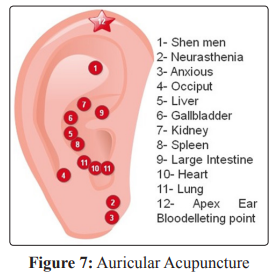
The apex ear bloodletting procedure is important in the majority the treatments of the author because, as she did a research in her clinic from 2015 to 2020, she revealed that the majority of patients that she was attending were in the lowest level of energy, leading to the formation of internal Heat, This research was presented in many webinars during the 2020 and it is in the course for publication in an article entitled Energies Alterations and Chakras’ Energies Deficiencies and Propensity to Coronavirus Infection. When the patient is suffering from energies deficiencies, the body will respond producing internal Heat, as demonstrated in many articles of the author such as Why Do Patients Still Catch Hospital Infections Despite the Practice of Infection Prevention and Control Programs? published by Acta Scientific Microbiology on May, 2018. Using this tool ( apex ear bloodletting), shown in the Figure 7, the author could release and take out the internal Heat formation that, associated with Chinese dietary counseling, was creating an internal energy balance state, leading in heath of the body again [12].
Concerning the use of medications to treat this patient, the author used only highly diluted medications to replenish the chakras’ energies centers, and using this tool, it was possible to treat all the patient’s symptoms at the same time even the physician does not know that the patient have such problem or disease, as demonstrated in many articles of the author concerning the case of the patient that had pain in the legs and improved his glaucoma condition after doing acupuncture for the treatment the pain in the legs. In this case, the doctor was not aware the patient’s glaucoma condition but all the patient’s symptoms and diseases improved at the same time, as she usually treats the root of the problem, that are the energies imbalances and not just the symptoms [12-16, 21-22].
The medications used to replenish the chakras’ energies centers were described in the Table 2.
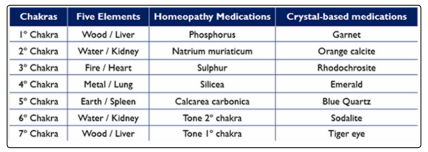
The intake of these homeopathy medications need be in the sequence of the generation cycle of the Five Elements theory, shown in the Figure 4. These medications need to be used in a period of one year or more when the chakras’ energies centers were measured again to see if there is a necessity of continuing the medications or not [12-16, 21-22].
The medications that the patient will need to use will be according to the radiesthesia method described by the author in several of her articles. This method is a to describe the ability to detect the radiation emitted by a person, object or geographical feature. In the case of the author, who usually uses the radiesthesia procedure to study the energy of the patients, she will analyze the energy status of each massive organ (Liver, Heart, Spleen, Lung and Kidney) according to the study entitled The Geometry of Emotions: Using Chakra Acupuncture and 5-Phase Theory to Describe Personality Archetypes for Clinical Use written by Chase Christopher [23].
Another important fact that must be considerate is the concentration of the medications. Arndt-Schultz’s law, originally formulated in1888, states the effects of different drug concentrations on an individual basis. The rule states that for all substances, small doses stimulate, moderate doses inhibit and overdoses kill (Figure 8) [24].
According to this law, highly diluted drugs improve organic processes, while high concentrations harm health. In the case of prescription drugs with high concentrations, in any case, they will be reducing more the vital energy, as demonstrated on the case report on this study, which already had deficiency of energy on all the chakras’ energies centers. In the case reports described in this study, the patient received indication for the use of highconcentrated medications ( anti-depressant medications ), as demonstrated the patient already had energy deficiencies shown in the Figure 5, and the use of this medication, despite cause some symptomatic improvement, could harm the vital energy of the patient, maintaining the imbalance, what could cause other diseases on the future such as diabetes, depression, hypertension, anxiety, etc, already published by the author in other articles such as Why Do Patients Still Have Anxiety Symptoms Despite the Use of Psychotropic Medications? published by Archives of Neurology and Neuro Disorders on March 2019 [12-16, 21-22, 24-25].
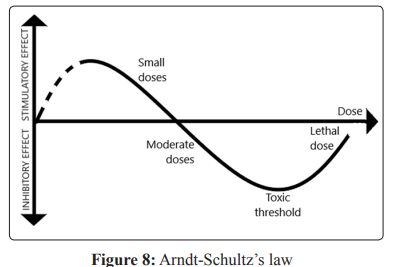
When the patients are treated holistically thought Chinese dietary counseling, auricular acupuncture to rebalance the internal energies and taking out the Heat retention thought apex ear bloodletting, and the chakras’ energies centers are treated in any type of dependency, the person gets out of depression and the anxiety decreases, so the person is not so inclined to want to plug that hole he feels with these substances, whatever it may be [12-16, 21-22, 24-25].
In this case, the author is talking about marijuana, but it could be any other type of chemical substance, because the important thing is to treat the energy imbalance of the chakras and with that the patient will feel well, stronger to overcome, will be less depressed, less anxiety, to be able to support the problems, the loads that each one has [12-16, 21-22, 24-25].
Nowadays, Western and traditional Chinese medicine are seen as different by most physicians around the world. However, they can be integrated. The body, and therefore, the possible treatments, is not only physical and constituted of organs and tissues, but also it is formed of energy. A metaphor of Yin and Yang as the different kinds of medicine was created by the author. For the adequate treatment of addiction on marijuana, it is important to understand the concepts of traditional Chinese medicine (root level) and Western medicine (leaf level), so the patient can treat the symptoms (leaf level) and the root of the problem, which are the energy imbalances [12-16, 21-22, 24-25].
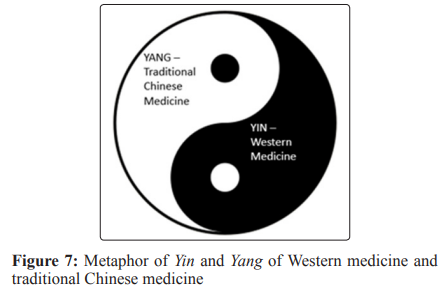
The author emphasize that all tools used to treat the patient using acupuncture and homeopathies medications are considered medical specialties by the Federal Medical Council in Brazil, since 1995 and 1980, respectively [26].
According to Hippocrates, healing is a matter of time but sometime, it is a matter of opportunity [6].
The conclusion of this study is that to treat patients with addiction in marijuana it is important to balance the internal energies and replenish the chakras’ energies that are deficient, improving selfsteam, depression, anxiety, fear, sleep, sexual function, etc., giving the energy condition to live normally.
